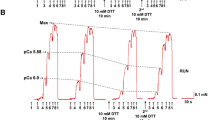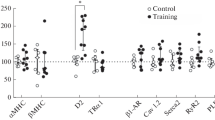Abstract
The effects of 8 weeks of interval running and of 14 days of thyroxine treatment were studied on selected cardiac functional and biochemical parameters of contraction in both female guinea pigs and rats. Relative to their respective sendentary-control groups, both trained groups demonstrated typical exercise adaptations of resting bradycardia and of increases in skeletal muscle oxidative enzymes and relative heart mass (P<0.05). Myosin ATPase, Ca2+ regulated myofibril ATPase, and +dP/dt max were at least two-fold higher in rats compared to guinea pigs (P<0.001). Physical training did not augment any of these parameters in either species under the experimental conditions studied. However, biochemical and functional indices of intrinsic cardiac contractility in guinea pigs were increased by injections of thyroxine; whereas, the same treatment regimen was without effect on the rats. These findings suggest that chronic running does not alter the intrinsic cardiac contractility state in either species. Also, exercise doesn't change the thyroid state of the guinea pig to a level sufficient to affect cardiac function.
Similar content being viewed by others
References
Baldwin KM, Cooke DA, Cheadle WG (1977) Time course adaptations in cardiac and skeletal muscle to different running programs. J Appl Physiol: Respirat Environ Exercise Physiol 42:267–272
Baldwin KM, Winder WW, Holloszy JO (1975) Adaptation of actomyosin ATPase in different types of muscle to endurance exercise. Am J Physiol 229:422–426
Baldwin KM, Terjung RL (1975) Effect of endurance running on the biochemical properties of cardiac muscle. Med Sci Sport 7:69 (abstract)
Barnard RJ, Duncan HJ, Baldwin KM, Grimditch G, Buckberg GD (1980) Effects of intensive exercise training on myocardial performance and coronary blood flow. J Appl Physiol: Respirat Environ Exercise Physiol 49:444–449
Bhan AK, Scheuer J (1975) Effects of physical training on cardiac myosin ATPase activity. Am J Physiol 228:1178–1182
Carey RA, Ritzer TF, Bove AA (1979) Effect of endurance training on myocardial myosin adenosine triphosphatase activity of the dog. Med Sci Sport 11:308–312
Clausen JP (1977) Effect of physical training on cardiovascular adjustments to exercise in man. Physiol Rev 57:779–815
Dowell RT, Cutilletta AF, Sodt PC (1975) Functional evaluation of the heartin situ. J Appl Physiol 39:1043–1047
Dowell RT, Cutilletta AF, Rudnik MA, Sodt PC (1976) Heart functional responses to pressure overload in exercise and sedentary rats. Am J Physiol 230:199–204
Dowell RT, Stone HL, Sordahl LA, Asimakis GK (1977) Contractility function and myofibril ATPase activity in the exercisetrained dog heart. J Appl Physiol: Respirat Environ Exercise Physiol 43:977–982
Fiske CR, Subbarow (1925) The colorimetric determination of phosphorous. J Biol Chem 66:375–400
Giusti R, Bershon MM, Malhotra A, Scheuer J (1978) Cardiac function and actomyosin ATPase activity in hearts of conditioned and deconditioned rats. J Appl Physiol: Environ Respirat Exercise Physiol 44:171–174
Goodkind J (1968) Left ventricular myocardial contractile response to aortic constriction in the hyperthyroid guinea pig. Circ Res 22:605–614
Gornall AG, Bardawill CJ, David MM (1949) Determination of serum proteins by means of the biuret method. J Biol Chem 177:751–756
Henderson AH, Craig RJ, Sonnenblick EH, Urschel CW (1970) Species difference in intrinsic myocardial contractility. Proc Soc Exp Med 134:930–932
Laemmli UK (1970) Cleavage of structural proteins during assembly of the head of bacteriophage T4. Nature 227:680–685
Morkin E (1979) Stimulation of cardiac myosin adenosine triphosphatase in thyrotoxicosis. Circ Res 44:1–7
Penpargkul S, Repke DI, Katz AM, Scheuer J (1977) Effect of physical training on calcium transport by rat cardiac sarcoplasmic reticulum. Circ Res 40:134–138
Rovetto MJ, Hjalmarson AC, Morgan HE, Barrett MJ, Goldstein RA (1972) Hormonal control of cardiac myosin adenosine triphosphatase in the rat. Circ Res 31:397–409
Scheuer J, Tipton CM (1977) Cardiovascular adaptations to physical training. Ann Rev Physiol 39:221–251
Shiverick KT, Thomas LL, Alpert NR (1975) Purification of cardiac myosin: Application to hypertrophied myocardium. Biochim Biophys Acta 393:124–133
Sonnenblick EH, Parmley WW, Urschel CW (1969) The contractile state of the heart as expressed by force velocity relations. Am J Cardiol 23:488–503
Srere PA (1969) Citrate synthase. Methods Enzymol 13:3–5
Stone HL (1977) Cardiac function and exercise training in conscious dogs. J Appl Physiol: Respirat Environ Exercise Physiol 42:824–832
Thyrum PT, Kritcher EM, Luchi RJ (1970) Effect ofl-thyroxine on the primary structure of cardiac myosin. Biochim Biophys Acta 197:335–336
Terjung RL, Winder WW (1975) Exercise and thyroid function. Med Sci Sports 7:20–26
Tibbits G, Koziol BJ, Roberts NK, Baldwin KM, Barnard RJ (1978) Adaptation of the rat myocardium to endurance training. J Appl Physiol Respirat Environ Exercise Physiol 44:85–89
Author information
Authors and Affiliations
Rights and permissions
About this article
Cite this article
Baldwin, K.M., Ernst, S.B., Herrick, R.E. et al. Effects of physical training and thyroxine on rodent cardiac functional and biochemical properties. Pflugers Arch. 391, 190–194 (1981). https://doi.org/10.1007/BF00596169
Received:
Accepted:
Issue Date:
DOI: https://doi.org/10.1007/BF00596169




